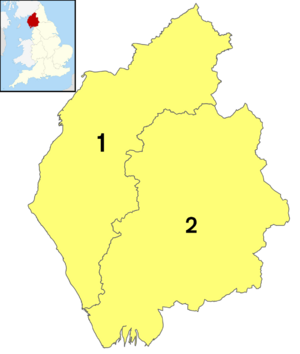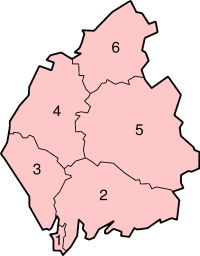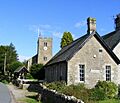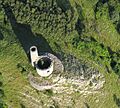
A map of
Cumbria, showing the districts: (1) Cumberland; (2) Westmorland and Furness.

A map of Cumbria, showing the pre-2023 districts: (1) Barrow-in-Furness; (2) South Lakeland; (3)
Copeland; (4)
Allerdale; (5)
Eden; and (6)
Carlisle.
In England, a civil parish is the smallest type of local government. Think of it as a small community or area that has its own local council to look after local matters. In Cumbria, there are 284 civil parishes, covering most of the county. In 2001, about 73.8% of Cumbria's population lived in these parishes.
These modern civil parishes are mostly based on older church areas. Back in the day, these church areas, called ecclesiastical divisions, also handled some local government tasks through a group called the Vestry committee.
How Parishes Began
Early Responsibilities
Civil parishes have a long history. In 1555, a law called the Highways Act 1555 made parishes responsible for keeping roads in good condition. Everyone in the parish had to work on the roads for four days a year, bringing their own tools and horses! An unpaid local person, called the Surveyor of Highways, watched over the work.
Later, in 1572, and more formally with the Poor Law Act 1601, parishes also became responsible for helping people who were poor. They would collect a special tax, called a rate, to support those in need.
Changes Over Time
During the 1800s, parishes gained more responsibilities, though the power to help the poor moved to larger groups called Poor Law Unions. In 1872, the Public Health Act 1872 grouped parishes into Rural Sanitary Districts. These later became the basis for what were known as Rural Districts.
Parishes used to be run by vestries, which were annual meetings where officials were chosen. Over time, some larger parishes had smaller areas called townships that managed their own poor relief. A law in 1882 made these townships into their own independent civil parishes.
Modern Parish Councils
The civil parishes we know today really started with the Local Government Act 1894. This law got rid of the old vestries and set up elected parish councils in rural areas where there were more than 300 voters. It also grouped rural parishes into Rural Districts and made sure parish boundaries matched county and borough boundaries.
Even towns had civil parishes, often matching their larger urban areas. However, these urban parishes didn't have elected councils. Their main job was to choose people for the Poor Law Unions. When the Poor Law system ended in 1930, these urban parishes mostly stopped having a real purpose.
The Local Government Act 1972 kept civil parishes in rural areas. Many former urban areas that were being dissolved became new parishes. Some very large urban areas, however, became "unparished areas," meaning they didn't have a civil parish council.
Parishes Today
Forming New Parishes
In recent years, governments have encouraged communities to form their own town and parish councils, even in areas that didn't have them before. The Local Government and Rating Act 1997 even gave local residents the right to ask for a new civil parish to be created in their area.
Naming Your Council
A parish council can decide to call itself a town council if it wants to. It can also become a city if the King or Queen grants it special city status. The leader of a town or city council is called a mayor.
The Local Government and Public Involvement in Health Act 2007 introduced even more options. Now, a parish council can choose to be called a community council, village council, or neighbourhood council. This allows them to pick a name that best fits their local area.
Images for kids
-
Sailing yachts at Nichol End
-
-
-
-
-
Landing stage, Scarness Bay, Bassenthwaite
-
The site of Caer Mote Roman Fort
-
What was the Sun Inn, Torpenhow
-
-
Moota Inn and the old road
-
Old Chapel, Bolton Low Houses
-
Surprise View, above Derwent Water
-
-
Main street in Bowness-on-Solway
-
St Bridget's Church, Bridekirk
-
-
The church and pub, Bromfield
-
Broughton Evangelical Church
-
Public Footpath Broughton Moor
-
-
Streamside gardens in Caldbeck
-
-
The River Derwent, Cockermouth
-
Church of St John the Evangelist, Crosscanonby
-
-
Entrance to St Mungo's Church
-
-
-
The Parish Church of St Mary, Gilcrux
-
Old School in Great Clifton
-
Overend Road, Greysouthen
-
View towards Allonby including Mealo House
-
The River Waver, Abbeytown
-
Channel of River Wampool, Solway Estuary
-
-
St Cuthbert's Church, Holme St Cuthbert
-
-
Crow Park lakeshore & landing stages on Derwent Water
-
-
-
-
-
Looking across Loweswater to Mellbreak
-
-
-
-
St Cuthberts Church, Plumbland
-
-
River Caldew near Sebergham
-
Hewthwaite Hall, Setmurthy
-
-
Skinburness Marsh and the River Waver Channel
-
-
Footpath to Micklethwaite
-
Underskiddaw - Derwentwater
-
-
-
-
-
-
-
Wedding cars leaving St. Michael's Church
-
-
-
Furness Brick Company, Askam-in-Furness
-
St Mary's Church, Dalton-in-Furness
-
-
-
-
Geese In the snow at Kirkandrews on Eden
-
Sheep grazing in the grounds of Bewcastle
-
-
The King Edward I Monument, Burgh Marsh
-
-
Country Lane towards Hall's Tenement
-
-
Turbine house at the water treatment works
-
Village centre, Cummersdale
-
-
-
Dalston church and lych gate
-
-
Cottages at Toppin Castle Farm
-
-
Solway Aviation Museum, Carlisle Airport
-
-
-
-
-
Stile by Cold Fell summit
-
St. Cuthbert's Church, Nether Denton
-
-
The Wellington Inn, Great Orton
-
The tidal River Eden at sunset
-
-
-
-
-
-
Turret 48a (Willowford East)
-
-
Hadrian's Wall at Birdoswald
-
Blackford Church in Cumbria
-
-
-
Beckermet St Bridget's Church
-
My house (and St Michael's and All Angels Church!)
-
Wath Bridge, Lake District
-
-
Cottages by the A595 at Holmrook
-
-
Ennerdale Water looking east
-
-
-
-
-
St Michael's Church, Lamplugh
-
-
Nethertown Railway Dwellings, Caravan Park and Sellafield
-
-
Barn near gorse in full bloom
-
-
-
Storm Clouds over Sellafield
-
-
-
Ulpha Bridge over the Duddon
-
Churchyard, St John's Church
-
-
-
St Mary's Church, Whicham
-
-
-
-
-
-
-
St Patrick's Church Bampton Grange
-
Looking towards Ullswater from Pooley Bridge
-
-
-
-
-
-
-
-
-
High Cup Nick with light dusting of snow
-
-
-
Ford and Stepping Stones at Crosby Ravensworth
-
All Saints Church, Culgaith
-
-
-
-
St. Cuthbert's Church, Great Salkeld
-
Stile on a footpath to Melkinthorpe Wood
-
Tranquil outskirts of Greystoke
-
-
-
-
-
-
-
-
Methodist Chapel at King's Meaburn
-
Frank's Bridge Kirkby Stephen
-
Forester's Hall, Kirkby Thore
-
-
-
-
Edge of the wood near Sheriff Park
-
The Institute, Long Marton
-
-
-
Ullswater from north of Howtown
-
Late afternoon view across Ullswater
-
Travellers' Recreation on A686
-
-
-
The Mill Inn, Mungrisdale
-
-
-
-
Approach to Newbiggin Hall
-
-
-
Waverley Temperance Hotel
-
Travellers' Recreation on A686
-
-
-
St Oswald's Church, Ravenstonedale
-
St Michaels Church, Shap with Swindale
-
-
-
-
-
-
-
-
Gravestones in the church yard, Temple Sowerby
-
Former Mission Room at Threlkeld
-
Disused railway route near Waitby
-
-
-
-
Eden Millennium Monument, Eamont Bridge
-
-
Footpath by Duddon Mosses
-
Sunset on the Kent Estuary from Arnside
-
-
-
The Shoreline, Lake Coniston
-
-
The Square Broughton in Furness
-
Burton House, Burton-in-Kendal
-
Garden at Beech Hill Hotel
-
-
-
Haverthwaite Steam Railway loco
-
-
-
-
-
-
-
-
-
-
Thornleigh Hotel, The Esplanade, Grange-over-Sands
-
Lowgill Viaduct, Lune Valley
-
-
-
-
St Peter's Church, Heversham
-
-
Bridge over the Lancaster Canal
-
St Anne, Ings, Cumbria - Organ
-
The Rakes, Hutton Roof Crags
-
-
Descending the farm track from Whiteside End into Kentmere
-
-
Slate waste, Kirkby Slate Quarries
-
St Mary's Church, Kirkby Lonsdale, The Gazebo
-
-
-
-
-
-
Channel in the sand off Humphrey Head
-
-
-
Dramatic skies over the Lune Valley
-
-
-
-
Cross Keys Hotel, Milnthorpe
-
-
Through the railway bridge, Staveley
-
-
-
Bortree Stile on the Cumbria Way
-
-
-
Pasture land north of Preston Patrick Hall
-
-
Windermere, near Holme Well
-
-
-
-
-
-
Northern end of Lancaster Canal
-
Windermere at Fell Foot Park
-
-
-
-
-
Orphan Crag Barn Cottage at Underbarrow
-
Great Urswick United Reformed Church
-
-
-
See also
- List of civil parishes in England





























































































































































































































































































